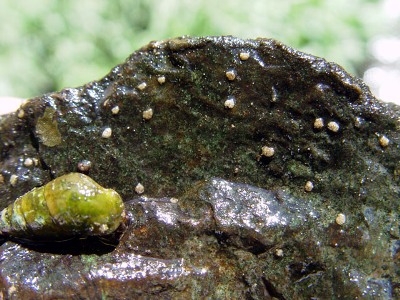Reproduction
Pleurocera acuta is a diecious snail, meaning that the sexes are separate (Dazo, 1965). According to Dazo, males often lack external genitalia but the testes are one of the largest internal organs, taking up most of the internal cavity. These testes are light yellow in color but turn golden during the mating season due to the presence of pigmented granules. The closed reproductive system of a male includes the testes, sperm duct, prostate, and cytophore. The open part of the tract includes the lamina, permatophore organs, and a genital groove. In females there is a pit between the foot and right tentacle that is a pre-egg laying groove that leads from the mantle and papillae (Dazo, 1965).
Pleurocera acuta reaches sexual maturity at 18 months of age and can begin oviposition, also known as egg laying for the first time at two years of age (Dazo, 1965). Mating is most common in the fall when the snails are very active (Dazo, 1965). Pleurocera acuta practices egg laying in the spring months (Benson, 2011). The first ovipost is in April and will continue through may ending by June (Dazo, 1965). The eggs are laid in masses that contain anywhere from 1 to 19 eggs (Dazo, 1965). They are deposited on a variety of surfaces such as leaves, stones, and even other shells (Dazo, 1965; Hickman 2009). The eggs undergo protostomal development with spiral cleavage and direct development into hatched juveniles (Hickman, 2009). These juveniles hatch with single whorled shells (Dazo, 1965).
Next Topic:
Life History and Interactions
HOME
